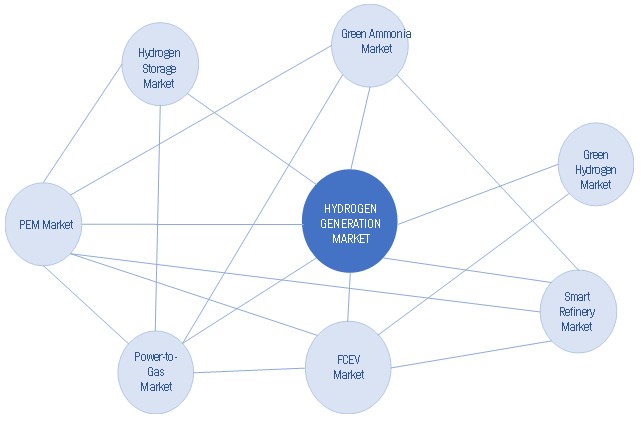Global Hydrogen Generation Market Scenario:
The hydrogen generation market size is expected to grow from an estimated USD 130 billion in 2020 to USD 201 billion by 2025, at a CAGR of 9.2% during the forecast period. Increasing fuel cell power generation application as well as increasing government regulations for desulphurization and greenhouse gas emissions are high growth prospects for the hydrogen generation market during the forecast period.

Market Economics:
A few major players that have a wide regional presence dominate the hydrogen generation market. The leading players in the hydrogen generation market include Linde (Germany), Air Products & Chemicals (US), Air Liquide (France), Uniper (Germany), and Engie (France).
Air Liquide (France) offers gases, technologies, and services to various end-user industries, such as healthcare, electronics, engineering & construction, and sciences & new energies. The company operates through 6 business segments: industrial merchant, large industries, healthcare, electronics, global markets & technologies, and engineering & construction.
Air Products & Chemicals (US) is a leading company in providing industrial atmospheric & specialty gases, performance materials, and equipment. The company operates its business through two reportable segments, namely, Industrial Gases and Corporate and other.
Download PDF Brochure –
https://www.marketsandmarkets.com/pdfdownloadNew.asp?id=494
The electrolysis technology segment is expected to grow at the highest CAGR from 2020 to 2025.
The increasing use of fuel cells in power generation and transportation is likely to drive the market for electrolysis. Through electrolysis, the electrolyzer system creates hydrogen gas. The oxygen that is left over is released into the atmosphere or can be captured or stored. This stored hydrogen can be supplied for other industrial processes or even used for medical gases in some cases. The hydrogen gas can either be stored as a compressed gas or liquefied, and since hydrogen is an energy carrier, it can be used to power any hydrogen fuel cell electric application — including trains, buses, trucks, or data centers. Measures have been taken by governments to boost the demand for water electrolysis. For instance, the US Department of Energy (DOE) has set technical targets and cost contributions for hydrogen production from water electrolysis.
Asia Pacific likely to emerge as the largest hydrogen generation market
In this report, the hydrogen generation market has been analyzed for four regions, namely, Europe, Asia Pacific, North America, South America, Middle East and Africa. Asia Pacific is one of the leading markets for adopting green technologies to meet the government targets for reducing GHG emissions. Japan and South Korea are heavily investing in fuel cell adoption since 2009 because of the commercial deployment of Japanese fuel cell micro-CHP products. Japan is the first nation to commercialize fuel cells and is supporting the projects related to the use of fuel cells in residential and automotive applications. It aims to deploy green hydrogen on a large scale. The country plans to have 200,00 green hydrogen fuel cell vehicles and 320 hydrogen refueling stations by 2025 to meet the global carbon emission standards. Singapore, India, and Malaysia are also showing interest and have just started or are expected to start exclusive programs to promote fuel cells in regional markets. These countries are initially focusing on backup power (stationary application) fuel cells.
Ask FREE Sample Pages- https://www.marketsandmarkets.com/requestsampleNew.asp?id=494
The blue hydrogen is expected to grow at the highest CAGR during the forecast period.
Blue hydrogen is derived from natural gas through steam methane reforming (SMR). SMR mixes natural gas with very hot steam in the presence of a catalyst, where a chemical reaction creates hydrogen and carbon monoxide. Additional water is added to the mixture, converting the carbon monoxide to carbon dioxide and creating more hydrogen. The carbon dioxide emissions produced are then captured and stored underground using the carbon capture, utilization, and storage (CCUS) technology, leaving nearly pure hydrogen. The cost of generating blue hydrogen is low. However, hydrogen also presents challenges when moved in large quantities, as it is light in weight. Alberta is aiming to export blue hydrogen globally by 2040. For instance, in October 2020, Alberta’s government announced a hydrogen strategy focused on carbon emissions to be competitive amid the global transition to sustainable energy. The strategy identifies the opportunity of using Albertas natural gas resources and its experience with carbon capture and storage (CCS) to produce low-emission blue hydrogen for local use or export to other domestic and international markets. Therefore, increasing demand for capturing and reusing carbon emissions drive the blue hydrogen segment.

